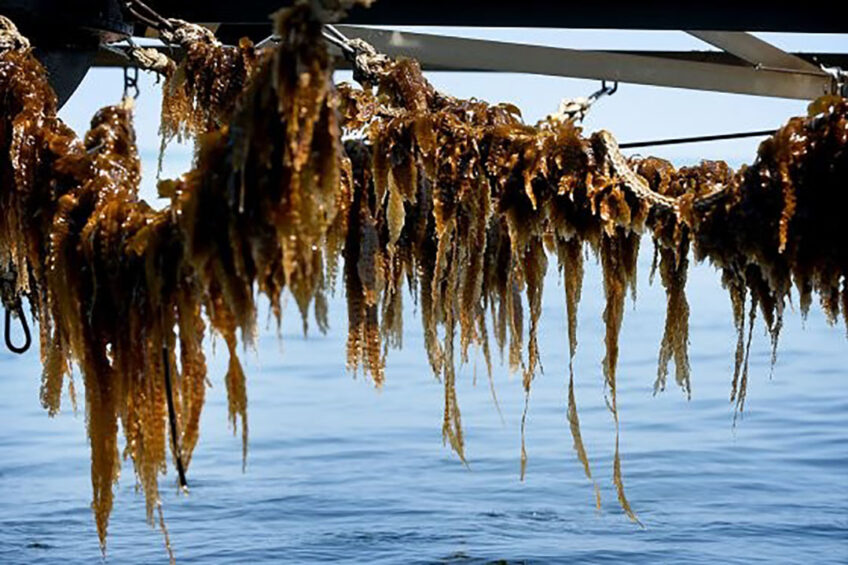Seaweed: A potential feed for ruminants

According to a study of Norwegian harvested seaweed, in which researches of Aarhus University have participated, using seaweed can be a potential feed for ruminants. Although it is connected to many challenges. For instance, it is a matter of the seaweed’s content of water, ash and potentially heavy metals as well as the preservation and transport costs of seaweed.
The purpose of the researchers was to study the nutritional and protein value of seaweed and whether seaweed can be preserved (ensiled). Table 1 shows the chemical composition and in vitro digestibility for some seaweed species harvested in Bodø, Norway.

High ash levels
The percentage of dry matter varied from 13 to 28%. This is just around the same range as seen for green crops grown on land, such as grass-clover, in which the percentage of dry matter depends on the weather (precipitation, sun, wind). The content of ash in the seaweed samples was significant even though the samples were not polluted with sand. Ash varies from 13 to 48% of dry matter in specie-averages as shown in Table 1, which is very high levels compared to ordinary feedstuff for cattle. Typically, the content of ash is below 10% of dry matter in the feedstuff we use for cattle, except from very soil-polluted grass-clover and beet tops silages. Thus, the content of ash is limiting for how much seaweed can account for in a total ration for cattle, and if seaweed is part of the feed ration, we should aim at taking advantage of the seaweed’s minerals.
Digestibility
The digestibility of organic matters measured in vitro by use of rumen fluid was very high for the red algae (75-86% of organic matter), which is at the same level or higher than for the best grass-clover silage. The green algae were lower (digestibility of 47-56% of organic matter), corresponding to seed grass straw in digestibility. For the brown algae, there was a very significant variation from extremely low digestible canalised wrack to high digestible oarweed (digestibility of 35-81% of organic matter).
The content of fibre (NDF) varied from 10 to 46% of dry matter. The NDF analysis is developed for land-based roughage crops and is also used for land-based concentrates. The use of the NDF analysis for seaweed may be discussed, as the polymeric carbohydrates in seaweed are particularly different from land-based feed crops.
Protein value of seaweed
The content of crude protein in the brown algae was moderate (9-14%), higher in the green algae (15-22%) and highest in the red algae (18-35% of dry matter). When making an assessment of the dry matter content one should consider the high content of ash. If ash is removed, or normalised to the level of land crops, the protein content in the organic matter, and thus potentially fermentable matter, will increase significantly.
Ruminants like cattle need protein, which is degraded in the rumen and which the microbes can use as a source of nitrogen. The studies show that the amino acid part of total crude protein in seaweed is at the same level as in land-based forage crops and that some seaweed species like for example purple laver seem to have a natural protection against degradation in the rumen while the digestibility feed-faeces is high. According to these studies, a seaweed species like Porphyra sp. will then be a highly appropriate source of supply for cattle with non-rumen-degradable, however digestible, feed protein.
Preservation
Wet harvested seaweed has a very short shelf life. Therefore, it must be used rather quickly, preferably within 24 hours after harvest. Otherwise, it should be preserved. Drying and freezing are both safe methods for preservation, but they are both too costly for large scale use for feed for cattle. In cattle farming, ensiling is the predominant method of preservation. As regards ensiling, there are important challenges, for example the high content of water, the high content of ash and the lack of a natural population of the lactic acid bacteria necessary for a normal ensiling and lactic acid fermentation. Preliminary results indicate that seaweed can be preserved by ensiling, but use of lactic acid bacteria as silage additive is required.
According to the researchers the price level of seaweed today is considerably above the price level of ordinary feedstuff used in cattle farming. They conclude that use of seaweed as major feed stuff will probably only be realistic if low cost supply is possible, as by-products from another production based on seaweed or where seaweed is harvested in fjords etc. for the purpose of removing nutrients from the aquatic environment.
The following Norwegian-led and Norwegian-financed seaweed projects were involved in this study: ALTPRO (Norges Forskningsråd), PROMAC (Norges Forskningsråd), PREMAC (Regionale Forskningsfond Nordnorge), OPENMAC (MABIT – Marin bioteknoloi program i Nordnorge).
Join 13,000+ subscribers
Subscribe to our newsletter to stay updated about all the need-to-know content in the dairy sector, two times a week.










